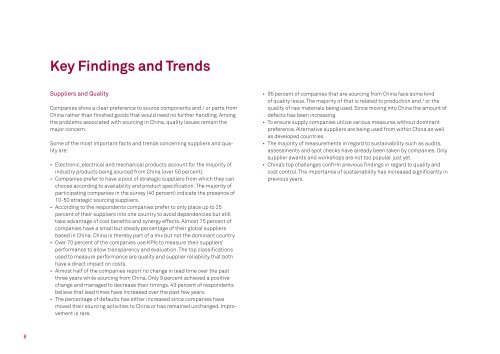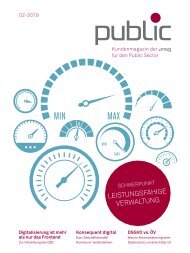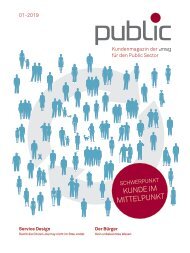01 | 2015 msg systems study
Sourcing in China
Sourcing in China
Create successful ePaper yourself
Turn your PDF publications into a flip-book with our unique Google optimized e-Paper software.
Key Findings and Trends<br />
Suppliers and Quality<br />
Companies show a clear preference to source components and / or parts from<br />
China rather than finished goods that would need no further handling. Among<br />
the problems associated with sourcing in China, quality issues remain the<br />
major concern.<br />
Some of the most important facts and trends concerning suppliers and quality<br />
are:<br />
••<br />
Electronic, electrical and mechanical products account for the majority of<br />
industry products being sourced from China (over 50 percent).<br />
••<br />
Companies prefer to have a pool of strategic suppliers from which they can<br />
choose according to availability and product specification. The majority of<br />
participating companies in the survey (40 percent) indicate the presence of<br />
10-50 strategic sourcing suppliers.<br />
••<br />
According to the respondents companies prefer to only place up to 25<br />
percent of their suppliers into one country to avoid dependencies but still<br />
take advantage of cost benefits and synergy effects. Almost 75 percent of<br />
companies have a small but steady percentage of their global suppliers<br />
based in China. China is thereby part of a mix but not the dominant country.<br />
••<br />
Over 70 percent of the companies use KPIs to measure their suppliers’<br />
performance to allow transparency and evaluation. The top classifications<br />
used to measure performance are quality and supplier reliability that both<br />
have a direct impact on costs.<br />
••<br />
Almost half of the companies report no change in lead time over the past<br />
three years while sourcing from China. Only 9 percent achieved a positive<br />
change and managed to decrease their timings. 43 percent of respondents<br />
believe that lead times have increased over the past few years.<br />
••<br />
The percentage of defaults has either increased since companies have<br />
moved their sourcing activities to China or has remained unchanged. Improvement<br />
is rare.<br />
••<br />
95 percent of companies that are sourcing from China face some kind<br />
of quality issue. The majority of that is related to production and / or the<br />
quality of raw materials being used. Since moving into China the amount of<br />
defects has been increasing.<br />
••<br />
To ensure supply companies utilize various measures without dominant<br />
preference. Alternative suppliers are being used from within China as well<br />
as developed countries.<br />
••<br />
The majority of measurements in regard to sustainability such as audits,<br />
assessments and spot checks have already been taken by companies. Only<br />
supplier awards and workshops are not too popular just yet.<br />
••<br />
China’s top challenges confirm previous findings in regard to quality and<br />
cost control. The importance of sustainability has increased significantly in<br />
previous years.<br />
8


















